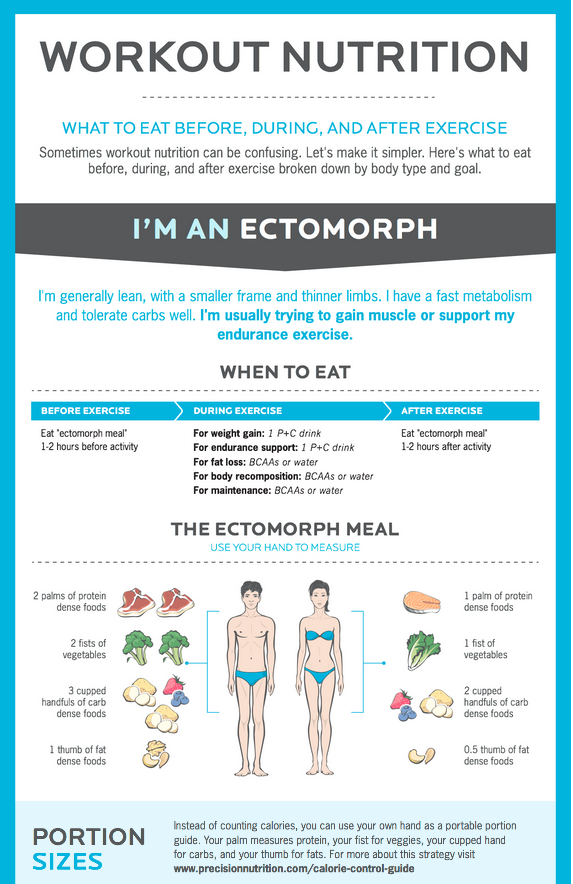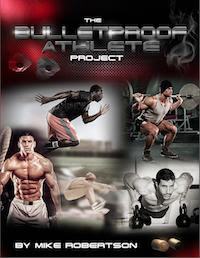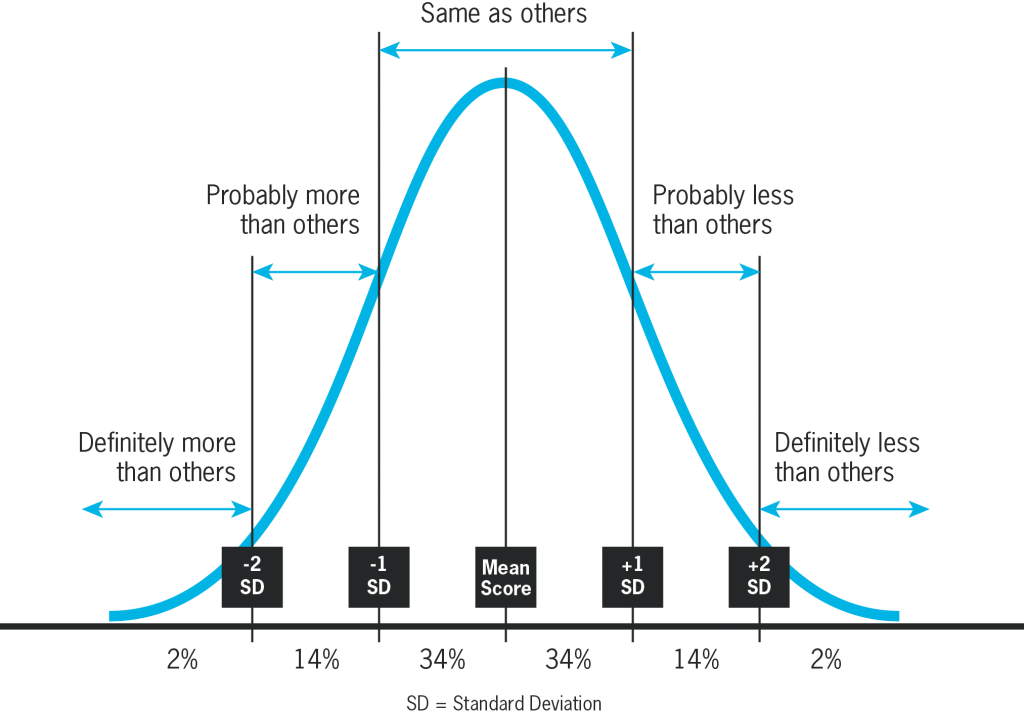Filed under: General Health, Nutrition, Training
A few weeks ago I wrote a comprehensive article for Precision Nutrition on appropriate nutrition protocols for working out and competing in athletic events. It was incredibly well received and gave general and specific outlines on what YOU should eat around your specific training and needs. Read it here.
Now, this was like a 4,000 word article. It went into great depth, and covered a lot of ground. But I also realize that not everyone is interested in reading 4,000 words. They just want to know what to do, and how to do it. The most practical takeaways.
So with that in mind, we came up with an awesome infographic that distills those 4,000 words down into an easy to understand and apply format. Here is a small screen shot of what it looks like:

It is based both on your body type (which is a general proxy for genetics, metabolism and carb tolerance) as well as your goals (which tends to cover your activity levels). Now clearly this can’t be entirely comprehensive, but it does give you a fantastic starting point for how to eat around your training and competition to give you the best results possible.
Go here to see the full infographic.
We also provide a fully printable version of the infographic to boot!
Before I take off to Winnipeg for the weekend (I am presenting at the Canadian Athletic Therapists Association 48th National Conference), I wanted to also let you know that Mike Robertson’s fantastic Bulletproof Athlete is $50 off until midnight this Sunday.
I don’t endorse too many products, but Mike consistently puts out top-notch content, and this product is his best yet.

In case you’re unfamiliar with the product, here’s a brief overview of what you’ll find in the Bulletproof Athlete training system:
- 16-weeks of done-for-you training programs. Mike has written all of your workouts for the next 16-weeks. All you have to do is show up and train!
- 3 Programs for 1 Price! This is not a one-size-fits-all training program, so he created three workouts that you can choose from to determine which is best for you given your needs, goals, and time available to train.
- 160+ Exercises in the Video Database. Mike also coaches and cues every exercise in the program to make sure you’re doing things right. No guessing on how to perform movements – just follow along and you’re good to go!
- Weekly Nutrition and Recovery challenges. Every week you get a nutrition and recovery goal to help you build solid habits. After all, it’s not how hard you train, it’s how fast you recover that’s important!
Filed under: General Health, Nutrition, Training, Weight Loss, Youth Training
A few months ago I wrote a somewhat controversial article for Precision Nutrition entitled Carb controversy: Why low-carb diets have got it all wrong.
The purpose of the article was to show that people’s carbohydrate needs vary depending on several factors, most importantly your activity level.
Many took the article to be bashing a low or lower carb approach, which it really was not. The title might make it seem that way, but the piece itself made it clear that there is a time and a place for a low carb approach. It’s just not all the time, for everyone.
In fact, here is how I think people’s carb needs fall:

As you can see, most people would do best with a more moderate approach, as it provides:
- ample protein and fat to meet needs and prevent deficiencies;
- adequate carbohydrates to meet needs and prevent problems of inadequate intake (testosterone dropping, cortisol rising, etc); and,
- the greatest flexibility and freedom in food and meal choices, allowing for the greatest long-term consistency (the real key to sustained success).
To me, there are 3 very distinct populations that I was speaking to with this piece:
1. The general population (of which about 70% tends to be overweight).
2. The fitness crowd.
3. Insulin resistant and/or sedentary individuals.
The goals of the general population tend to be fairly modest. They often just want practical and reasonable approaches to help them find a sustainable path to their goals. The approach I provided will do just that.
The fitness crowd tends to be a little carb-shy, much to their detriment. It is something that the Paleo/Crossfit crowd has discovered. They have been recommending people up their intake of carbs lately (generally from things like sweet potatoes) as they have discovered that long-term intense training combined with a low carb diet generally does not turn out well. People in the fitness industry, or who just love fitness, should match their carb intake to their genetics, goals and activity levels. They might be surprised what they find when they do.
Insulin resistant and/or sedentary individuals would do better with a reduced carbohydrate intake. Probably in that 1 standard deviation less than the average. In this case, the average carbohydrate intake that I was advocating for was only about 40% of calories. Assuming you eat about 4 times per day, this equates to ~2 cupped handfuls of carbs for men and ~1 cupped handful of carbs for women per meal. We generally recommend that insulin resistant and/or sedentary individuals cut carbs back to about 25% of calories. This equates to ~1 cupped handful of carbs for men and ~0.5 cupped handful of carbs for women per meal. People who are insulin resistant simply do not handle carbs well. And people who are sedentary simply do not need as many since they are not as active.
To put the final nail in the coffin, here are a few studies you may find interesting.
Overfeed study of fat vs carbs. They actually found overfeeding of fat to lead to greater fat accumulation than overfeeding of carbs - http://www.ncbi.nlm.nih.gov/pubmed/7598063
Overfeeding of fat vs carbs #2. No significant differences were found between eating 1200 excess fat or carb calories - http://www.ncbi.nlm.nih.gov/pubmed/11029975
And a review study that ultimately concluded that a moderate approach is generally the best approach to start most people on - http://www.ncbi.nlm.nih.gov/pubmed/15867892
And finally, a cool new site I have come across provides some fantastic information. I have no idea whose site it is, but their take on the low carb/high fat vs. high carb/low fat debate was fantastic and thoroughly referenced - http://fitnessrealitycheck.com/2014/04/30/high-carblow-fat-vs-low-carbhigh-fat-the-debate-to-end-all-debates/
I hope that provides a little clarity on the topic for everybody.
And if you pick up a copy of my Nutrition Guide to Kevin Neeld’s new Ultimate Hockey Transformation, you will now have an even better idea of why I make the carbohydrate recommendations that I do.
In this new program Kevin provides incredible in- and off-season programs for players at the U14, U16, U18, and Junior/College levels. He also provides a comprehensive video database of every exercise in the program. Along with a great manual describing why the programs are designed the way they are and exactly how to use/adjust them based on time, space, equipment, etc. It has everything you would ever need to make yourself into the best hockey player you can be.

Filed under: General Health, Nutrition, Training, Youth Training
I had the pleasure to write the Nutrition Guide to Kevin Neeld’s new Ultimate Hockey Transformation.

Ultimate Hockey Transformation is the follow-up training program series to Ultimate Hockey Training, and features year-round hockey-specific off-ice training programs for players at the U-14 age level and above. The Ultimate Hockey Transformation system includes:
- In- and off-season training programs for players at the U-14, U-16, U-18, and Junior/College levels totaling 120 weeks of programming!
- 228 high quality videos demonstrating how to perform every exercise in the program with perfect technique
- A 65-page manual outlining everything you need to know to successfully use the Ultimate Hockey Transformation system!
- Specific warm-ups, corrective exercise, and cooldowns to help you maximize your training preparedness and recovery
- A Performance Profiling Sheet so you can track your progress over time
- The UHT Recovery Monitoring Log so you can prevent overtraining before it occurs!
Simply, following the RIGHT training program can completely alter the course of your career. Propel your game to the next level by following training programs proven to deliver game-changing results!
Simply choose the Pro Package and you also get access to my brand new Nutrition Guide, which is unlike anything I have ever written. In this Nutrition Guide I take an entirely new and improved approach for athletes to improve their nutrition and boost their health, body composition, and performance.
Check it out ===>>> Ultimate Hockey Transformation.
Filed under: General Health, Nutrition
Bulletproof Coffee introduced the world to “coffee hacking” and the novelty of butter in one’s morning brew. As a result, it’s become something of an internet sensation. People are talking about it. People are trying it. Many even claim it works wonders for them.
But what is it about this magical concoction that has people pimping their cup of joe? More importantly, do the results actually match the hype?
To find out the answers, check out this piece I just wrote for PN that delves into the research, the clinical outcomes, and my own personal experiment with Bulletproof Coffee
===>>>http://www.precisionnutrition.com/bulletproof-coffee
On a related note, I wanted share a cool coffee tip with you.
As you may or may not know, you should wash your coffee maker on a semi-regular basis – say every 3-4 months. I usually recommend people run a pot of white vinegar through their machine, followed by 3-4 pots of water to remove any vinegar remnants.
The vinegar will kill any mold or mildew growing in your machine, as it is haven for them due to the moist and enclosed conditions.
However, it has recently come to my attention that this may not be enough. A biofilm often accumulates in coffee makers, preventing the vinegar from reaching the bacteria underneath. The best approach actually appears to be to use a stiff-bristle brush to scrub the biofilm, and break it down. Then put the pot of vinegar through, so it can do its work on the mold and mildew. Followed by the 3-4 pots of water.








Posted on May 30th, 2014 by Brian St. Pierre
3 Comments »